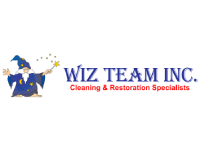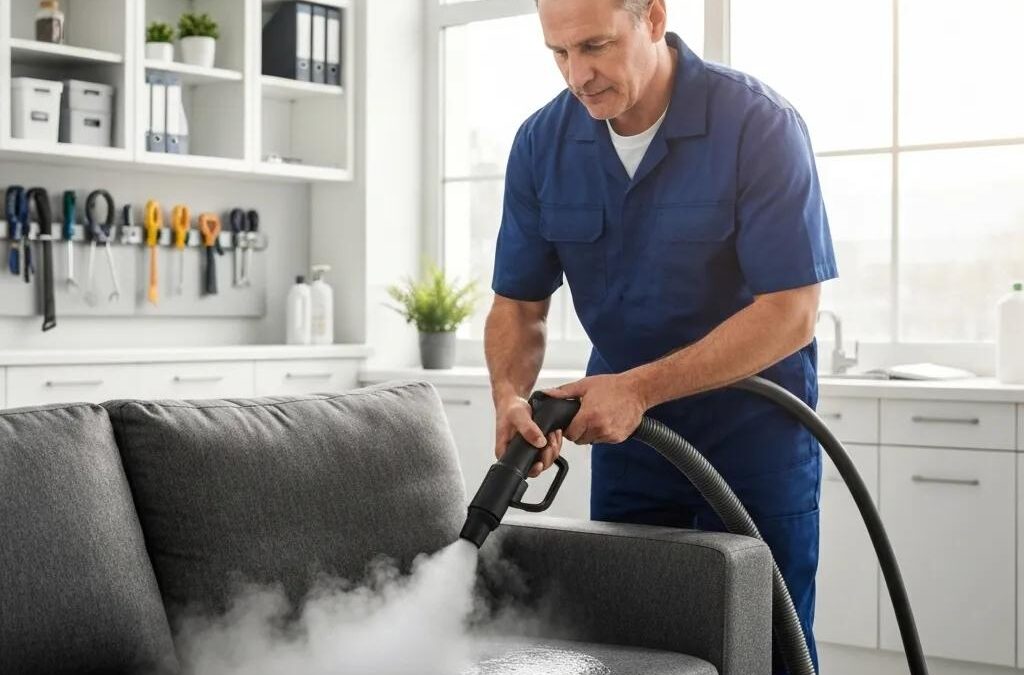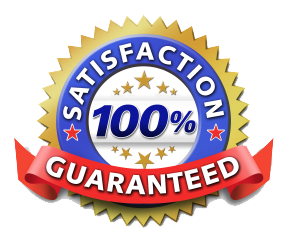Maintaining a healthy home begins with pristine upholstery, and the right upholstery steam cleaning techniques deliver deep sanitization without harming delicate fibers. Homeowners in Lake Forest, IL face challenges like pet stains, lingering odors, and allergen buildup that ordinary cleaning cannot remove. This guide defines key fabric types and industry cleaning codes, explains how hot water extraction works, details step-by-step protocols, addresses common stain and odor scenarios, and highlights when professional intervention is best. Along the way, readers will discover how certified, eco-friendly methods restore sofas and chairs safely and why partnering with a local expert is the smart solution.
What Are the Most Common Upholstery Fabrics and Their Cleaning Codes?
Understanding upholstery materials and their designated care labels is essential for selecting safe cleaning methods. Every fabric—from natural fibers like cotton and wool to synthetics such as microfiber—responds differently to moisture, solvents, and agitation. Cleaning codes (W, S, WS, X) serve as industry guidelines that protect fabric integrity and colorfastness during professional or DIY treatments.
Which Upholstery Fabrics Require Special Care?
Natural and specialty textiles demand extra precautions because their fibers react differently to heat and moisture:
- Leather & Suede: Porous hides can darken or crack if over-wet; use protein-based conditioners.
- Silk & Velvet: Dense pile and delicate weave lose luster under harsh chemicals or high heat.
- Wool & Linen: Natural fibers shrink or felt when cleaned with water above 120°F.
- Microfiber & Polyester Blends: Although robust, static and water spots occur without proper extraction.
Each of these materials benefits from targeted pretreatments and professional evaluation before steam cleaning, ensuring the safest outcome and long-term fabric resilience.
How Do Upholstery Cleaning Codes (W, S, WS, X) Affect Fabric Care?
Below is a quick reference to standard cleaning symbols:
| Code | Allowable Method | Mechanical Action |
|---|---|---|
| W | Water-based cleaner | Gentle agitation, steam |
| S | Solvent-only cleaner | Dry-foam or low-moisture |
| WS | Water or solvent | Versatile, mild extraction |
| X | Vacuum only | No liquids or solvents |
These codes guide technicians on whether hot water extraction, chemical solvents, or only vacuuming should be used. Adhering to them prevents shrinking, color bleeding, and fiber damage when scheduling a professional treatment.
Upholstery Cleaning Codes
Upholstery cleaning codes (W, S, WS, X) are industry guidelines that indicate the appropriate cleaning methods for different fabric types, preventing damage and ensuring effective cleaning. These codes are typically found on labels under furniture cushions.
What Are the Best Practices for Fabric-Specific Upholstery Care?
For each cleaning code and material, follow these recommendations:
- W fabrics: Use low-moisture extraction and rapid airflow to avoid overwetting.
- S fabrics: Opt for eco-friendly solvent gels and spot-treat stains before full cleaning.
- WS fabrics: Combine gentle water solutions with solvent boosters for tough soils.
- X fabrics: Maintain regular vacuuming and professional deep-clean only when dry methods exist.
- General precautions: Always spot-test in an inconspicuous area, groom fiber pile after cleaning, and allow thorough drying.
Applying these guidelines ensures that fabric-specific vulnerabilities are respected while restoring texture and appearance.
How Does Steam Cleaning (Hot Water Extraction) Work for Upholstery?
Steam cleaning, also known as hot water extraction, combines near-boiling water with high-powered suction to flush embedded dirt, oils, and allergens from upholstery fibers. This section explains the science behind the method and how it delivers a hygienic, refreshed finish.
What Is Steam Cleaning and How Is Hot Water Extraction Applied?
Hot water extraction involves heating water to 200°F–210°F, mixing it with a professional cleaning solution, and injecting it under pressure into upholstery. The equipment’s suction then recovers water and dissolved soils into a recovery tank. This process:
- Loosens ground-in particles and oils.
- Suspends soil in the liquid solution.
- Removes residue through strong vacuum recovery.
Technicians calibrate temperature, pressure, and extraction speed to match fabric codes, achieving maximum soil removal without fiber stress.
What Are the Key Benefits of Steam Cleaning Upholstery?
Steam cleaning upholstery provides multiple advantages:
- Deep-clean action removes up to 98% of allergens, dust mites, and bacteria.
- High-temperature sanitization kills mold spores and dust-borne pathogens.
- Quick drying (2–6 hours) reduces the risk of mildew growth.
- Gentle agitation preserves nap, texture, and color integrity.
- Eco-friendly detergents minimize chemical residue and indoor-air toxins.
These benefits support healthier living spaces by eliminating pollutants and extending furniture lifespan.
Benefits of Hot Water Extraction
Hot water extraction, also known as steam cleaning, effectively removes dirt, allergens, and bacteria from upholstery, providing a deep clean and sanitization. This method is particularly beneficial for allergy sufferers.
This source supports the article’s explanation of how steam cleaning works and its benefits, such as allergen removal and sanitization.
Is Steam Cleaning Safe for All Upholstery Fabrics?
Yes, when matched to cleaning codes and material properties. Certified technicians adjust water temperature and suction to accommodate delicate textiles like silk or wool. Fabrics labeled S or X require alternative low-moisture or vacuum-only treatments, but most W and WS surfaces respond well to controlled steam cleaning. Proper pre-inspection and spot testing secure fabric safety across a wide range of upholstery.
How to Steam Clean Upholstery: A Step-by-Step Guide
A systematic approach ensures efficient, damage-free upholstery renewal. The following procedures—backed by professional protocols—maximize soil removal and uniform drying.
How Should You Prepare Upholstery Before Steam Cleaning?
Before engaging hot water extraction, complete these four preparatory steps:
- Vacuum Thoroughly – Remove loose debris and pet hair with a high-filtration vacuum.
- Spot Test – Apply cleaning solution on a hidden seam to confirm colorfastness and fiber stability.
- Pre-treat Stains – Use enzyme or solvent-based spotters for pet stains, grease, and ink.
- Protect Surroundings – Shield floors and baseboards with drop cloths to catch overspray.
These measures set the stage for safe, comprehensive cleaning and prevent mishaps in a residential setting.
What Is the Proper Steam Cleaning Process for Upholstery?
Follow this numbered protocol for uniform results:
- Adjust Equipment – Set temperature to 200°F and pressure to 100–150 psi.
- Apply Cleaning Solution – Use an upholstery attachment to lightly mist the fabric.
- Allow Dwell Time – Let the solution penetrate 5–7 minutes to break down soils.
- Perform Extraction Passes – Move the wand slowly, overlapping strokes to recover moisture and contaminants.
- Rinse if Needed – For heavy soils, flush fibers with plain hot water and extract thoroughly.
- Final Grooming – Lightly brush pile to reset texture and avoid matting.
Precision at each stage ensures deep penetration of cleaning agents and efficient moisture recovery.
How Do You Care for Upholstery After Steam Cleaning?
Post-cleaning routines are critical for lasting results:
- Dry in Controlled Conditions – Use air movers to reduce drying time to 2–4 hours.
- Groom Fiber Nap – Smooth pile with a soft brush or grooming tool.
- Apply Fabric Protector – Seal fibers with an eco-friendly barrier against future spills.
- Monitor for Remaining Spots – Retreat any persistent stains promptly to avoid set-in marks.
Maintaining proper post-service care completes the steam cleaning cycle and preserves fabric quality for months to come. To explore our full range of professional solutions, Our Comprehensive Cleaning Services are available to tailor every step to your needs.
How Can You Remove Common Stains and Odors from Upholstery?
Targeted problem-solution strategies restore appearance and freshness, whether tackling pet mishaps, food spills, or musty smells.
What Are the Best Methods for Pet Stain and Food Spill Removal?
Address fresh and set-in spots with these techniques:
- Enzyme Cleaners – Break down protein-based pet stains, then extract with hot water.
- Solvent Spotters – Dissolve grease and oil from meal drips before full steam cleaning.
- Blotting and Extraction – Always blot excess liquid first, then use low-moisture extraction to lift residue.
- Repeat Treatment – Tough stains may require two or more cycles for complete removal.
Successful stain elimination depends on fast action and professional-grade spotters that protect fabric strength.
How Do You Eliminate Pet Odors and Musty Smells from Upholstery?
Neutralizing odors demands more than masking fragrances:
- Baking Soda Application – Sprinkle, let sit for 30 minutes, then vacuum to absorb ammonia and odors.
- Activated Charcoal Packs – Place near upholstered items to pull volatile compounds from fibers.
- Steam Sanitization – High-temperature extraction kills bacteria that cause persistent smells.
- Enzyme Rinse – Rinse fabrics with an enzyme-enhanced solution to digest odor molecules at the source.
Combining odor-absorbent powders with hot water extraction restores a fresh environment.
How Does Professional Cleaning Reduce Allergens and Prevent Mold?
Expert steam cleaning removes up to 95% of dust mites, pollen, and pet dander, while high-heat sanitization halts mold spore growth in damp upholstery. Certified technicians complete moisture recovery protocols using commercial-grade air movers, ensuring fabrics dry quickly and remain inhospitable to microbial resurgence. This comprehensive process not only enhances indoor air quality but also strengthens furniture longevity.
Why Choose Professional Upholstery Cleaning Service in Lake Forest, IL?
Choosing a local specialist delivers peace of mind through certified expertise, eco-friendly practices, and personalized attention to your home’s needs.
What Makes Wiz Team Inc. the Trusted Upholstery Cleaning Expert?
With over 25 years of family-owned experience in Lake Forest, Wiz Team Inc. brings unmatched attention to detail and a customer-first guarantee. Technicians hold IICRC Master Textile Cleaner credentials, ensuring every sofa, loveseat, and chair receives tailored care based on fabric type, soil level, and manufacturer guidelines. Learn more about our signature process at Lake Forest Carpet Cleaning: Wiz Team Inc. Experts.
Professional Upholstery Cleaning in Lake Forest, IL
Professional upholstery cleaning services in Lake Forest, IL, offer expertise, certified technicians, and tailored care based on fabric type and cleaning codes, ensuring safe and effective cleaning.
How Do Certified Technicians Ensure Fabric-Specific Care?
IICRC certification validates advanced training in cleaning codes, fiber identification, and stain removal chemistries. Our specialists perform thorough pre-inspections, select appropriate detergents, and adjust equipment settings for each material’s unique tolerance—whether water-safe wool or solvent-only silk—minimizing risk and maximizing restoration.
IICRC Upholstery and Fabric Cleaning Technician (UFT) Certification
The IICRC UFT certification provides in-depth knowledge and skills for upholstery and fabric cleaning, covering fiber identification, cleaning methods, and potential problems. This certification is a “must-have” for professionals in the cleaning and restoration industry.
What Are the Benefits of Eco-Friendly Upholstery Cleaning Solutions?
Using plant-based detergents and green preservatives, our methods eliminate up to 99% of harsh chemicals. Sustainable formulas promote safer indoor air for families and pets, prevent residue buildup that attracts dirt, and reduce environmental impact. This holistic approach supports both home health and local ecosystem balance.
Eco-Friendly Upholstery Cleaning Solutions
Eco-friendly upholstery cleaning solutions, often plant-based, offer effective cleaning while minimizing the use of harsh chemicals, promoting safer indoor air quality, and reducing environmental impact.
Which Areas Does the Professional Upholstery Cleaning Service Cover?
Proudly serving Lake Forest and the North Shore Chicago suburbs, our locally based team provides on-time appointments, flexible scheduling, and a 100% satisfaction guarantee. Whether you live near sunrise landmarks or tucked into forested neighborhoods, our professionals arrive fully equipped to revitalize your upholstery with minimal disruption.
How Much Does Professional Upholstery Cleaning Cost in Lake Forest, IL?
Professional steam cleaning delivers superior value by combining deep soil removal with fabric protection. Typical investment ranges reflect furniture size, fiber type, and condition.
What Factors Influence Upholstery Cleaning Cost?
Key variables include:
- Fabric Type: Delicate or solvent-only materials require specialized solutions.
- Item Size: Sofas and sectionals incur higher labor and solution use.
- Soil & Stain Severity: Extra pretreatment and multiple passes increase time.
- Protective Finishes: Application of fabric sealants adds nominal fees.
- Travel & Setup: Local service fees cover equipment freight and preparation.
Transparent estimates ensure no surprises and clear justification for premium service.
How Does Professional Steam Cleaning Compare to DIY Methods in Cost and Effectiveness?
While rental machines and household cleaners may cost less upfront, they deliver inferior soil removal, leave residue, and often over-wet fabrics. Professional hot water extraction reaches deep-seated allergens and applies industry-grade detergents, translating to longer-lasting results, faster drying, and fewer repeat treatments. The small additional investment protects upholstery lifespan and home health.
What Are the Frequently Asked Questions About Upholstery Steam Cleaning?
In-depth answers to common concerns help homeowners plan and protect their furniture investment.
How Often Should Upholstery Be Professionally Cleaned?
Annual or biannual service preserves fabric vibrancy and removes accumulated allergens. High-traffic households or pet owners may benefit from quarterly attention to maintain hygiene and appearance.
Can Steam Cleaning Remove All Types of Stains and Odors?
Steam cleaning effectively lifts water-soluble soils, oils, and protein stains when combined with targeted pretreatments. Stubborn dye-based marks (e.g., permanent ink) may require specialized solvent spotting beyond standard extraction.
Is Steam Cleaning Safe for Delicate Fabrics Like Silk and Velvet?
Yes, when a certified technician calibrates temperature and suction to the fabric’s W or S code. Pre-inspection and spot testing determine the safest method—steam, low-moisture, or solvent-only—ensuring no damage to sensitive textures.
How Long Does Upholstery Take to Dry After Steam Cleaning?
Using high-velocity air movers, most pieces dry within 2–6 hours. Ambient humidity and fabric density affect time; proper airflow and grooming accelerate fiber reset and prevent mildew formation.
Maintaining pristine upholstery requires the right blend of knowledge, technique, and equipment. Professional upholstery cleaning techniques deliver unmatched deep cleaning, allergen reduction, and fabric protection for Lake Forest homes. Contact Wiz Team Inc. today to schedule an expert evaluation and experience the safe, effective care that brings your furniture back to life.




